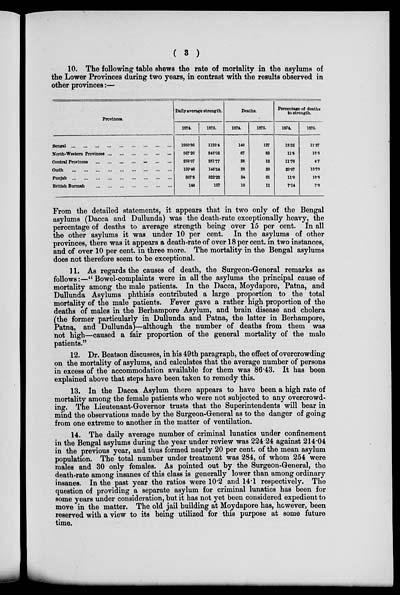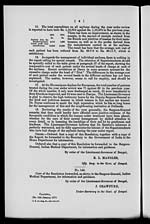Medicine - Mental health > 1867-1924 - Annual report of the insane asylums in Bengal > Insane asylums in Bengal annual reports 1867-1875 > Annual report on the insane asylums in Bengal for the year 1875
(873) Page 3
Download files
Individual page:
Thumbnail gallery: Grid view | List view

( 3 )
10. The following table shews the rate of mortality in the asylums of
the Lower Provinces during two years, in contrast with the results observed in
other provinces:—
|
Provinces. |
Daily average strength. |
Deaths. |
Percentage of deaths |
|||
|
1874. |
1875. |
1874. |
1875. |
1874. |
1875. |
|
|
Bengal ... ... ... ... ... ... ... ... ... |
1050.86 |
1126.4 |
140 |
127 |
13.32 |
11.27 |
|
North-Western Provinces ... ... ... ... ... ... |
567.26 |
542.02 |
67 |
88 |
11.8 |
15.3 |
|
Central Provinces ... ... ... ... ... ... ... |
238.07 |
251.77 |
28 |
12 |
11.76 |
4.7 |
|
Oudh ... ... ... ... ... ... ... ... ... |
139.46 |
145.54 |
28 |
20 |
20.07 |
13.73 |
|
Punjab ... ... ... ... ... ... ... ... ... |
307.5 |
322.23 |
34 |
61 |
11.0 |
18.8 |
|
British Burmah ... ... ... ... ... ... ... ... |
140 |
157 |
10 |
11 |
7.14 |
7.0 |
From the detailed statements, it appears that in two only of the Bengal
asylums (Dacca and Dullunda) was the death-rate exceptionally heavy, the
percentage of deaths to average strength being over 15 per cent. In all
the other asylums it was under 10 per cent. In the asylums of other
provinces, there was it appears a death-rate of over 18 per cent. in two instances,
and of over 10 per cent. in three more. The mortality in the Bengal asylums
does not therefore seem to be exceptional.
11. As regards the causes of death, the Surgeon-General remarks as
follows:—"Bowel-complaints were in all the asylums the principal cause of
mortality among the male patients. In the Dacca, Moydapore, Patna, and
Dullunda Asylums phthisis contributed a large proportion to the total
mortality of the male patients. Fever gave a rather high proportion of the
deaths of males in the Berhampore Asylum, and brain disease and cholera
(the former particularly in Dullunda and Patna, the latter in Berhampore,
Patna, and Dullunda)—although the number of deaths from them was
not high—caused a fair proportion of the general mortality of the male
patients."
12. Dr. Beatson discusses, in his 49th paragraph, the effect of overcrowding
on the mortality of asylums, and calculates that the average number of persons
in excess of the accommodation available for them was 86.43. It has been
explained above that steps have been taken to remedy this.
13. In the Dacca Asylum there appears to have been a high rate of
mortality among the female patients who were not subjected to any overcrowd-
ing. The Lieutenant-Governor trusts that the Superintendents will bear in
mind the observations made by the Surgeon-General as to the danger of going
from one extreme to another in the matter of ventilation.
14. The daily average number of criminal lunatics under confinement
in the Bengal asylums during the year under review was 224.24 against 214.04
in the previous year, and thus formed nearly 20 per cent. of the mean asylum
population. The total number under treatment was 284, of whom 254 were
males and 30 only females. As pointed out by the Surgeon-General, the
death-rate among insanes of this class is generally lower than among ordinary
insanes. In the past year the ratios were 10.2 and 14.1 respectively. The
question of providing a separate asylum for criminal lunatics has been for
some years under consideration, but it has not yet been considered expedient to
move in the matter. The old jail building at Moydapore has, however, been
reserved with a view to its being utilized for this purpose at some future
time.
Set display mode to: Large image | Zoom image | Transcription
Images and transcriptions on this page, including medium image downloads, may be used under the Creative Commons Attribution 4.0 International Licence unless otherwise stated. ![]()
| Permanent URL | https://digital.nls.uk/83380616 |
|---|




